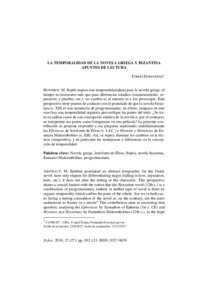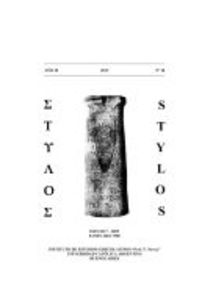Por favor, use este identificador para citar o enlazar este ítem:
https://repositorio.uca.edu.ar/handle/123456789/9785| Título: | La temporalidad de la novela griega y bizantina : apuntes de lectura | Autor: | Fernández, Tomás | Palabras clave: | LITERATURA GRIEGA; NOVELA; LITERATURA BIZANTINA; TIEMPO NARRATIVO; Bakhtin, M. M., 1895-1975; Jenofonte, ca. 430- ca. 355 a. C.; LITERATURA COMPARADA | Fecha de publicación: | 2018 | Editorial: | Universidad Católica Argentina. Facultad de Filosofía y Letras. Instituto de estudios grecolatinos "Prof. F. Nóvoa" | Cita: | Fernández, T. La temporalidad de la novela griega y bizantina : apuntes de lectura. [en línea]. Stylos, 2018, 27. Dispinible en: https://repositorio.uca.edu.ar/handle/123456789/9785 | Resumen: | Resumen: M. Bajtín supuso una temporalidad plana para la novela griega: el tiempo no transcurre más que para diferenciar estadios (enamoramiento, se-paración y pruebas, etc.); no cambia ni al entorno ni a los personajes. Esta perspectiva tiene puntos de contacto con el postulado de que la novela bizan-tina (s. XII) es una sumatoria de progymnasmata; en efecto, tampoco en este caso hay una temporalidad orgánica que unifique las partes del todo. ¿Se tra-ta en ambos casos de una concepción estática de la novela o, por el contrario, se interpretan sus partes como fotogramas en una película? La presente con-tribución se propone responder a esa pregunta analizando simultáneamente las Efesíacas de Jenofonte de Éfeso (s. I d.C.) e Hismine e Hisminias de Eu-macio Makrembolites (s. XII). Así, se espera iluminar los cambios en la téc-nica compositiva, y en particular las semejanzas y diferencias en la concep-ción de temporalidad. Abstract: M. Bakhtin postulated an abstract temporality for the Greek novel: time only elapses for differentiating stages (falling in love, separation, tests, etc.); it does not alter the setting or the characters. This perspective shares a crucial feature with the notion that the Byzantine novel (12th c.) is a combination of progymnasmata; indeed, in neither type of novel is there an organic temporality which unifies the parts of the whole. Are we in both cas-es facing a stating conception of the novel or, on the contrary, are the parts understood as frames in a movie? This contribution aims at answering that question, analysing the Ephesiaca by Xenophon of Ephesus (1st c. CE) and Hysmine and Hysminias by Eumathios Makrembolites (12th c.), in the hope of showing changes in compositive technique and, more particularly, the common and divergent points in the conception of temporality. |
URI: | https://repositorio.uca.edu.ar/handle/123456789/9785 | ISSN: | 0327-8859 | Disciplina: | LITERATURA | Derechos: | Acceso abierto | Fuente: | Stylos Nº 27, 2018 |
| Aparece en las colecciones: | STY - 2018 nro. 27 |
Ficheros en este ítem:
| Fichero | Descripción | Tamaño | Formato | |
|---|---|---|---|---|
| temporalidad-novela-griega.pdf | 200,54 kB | Adobe PDF |  Visualizar/Abrir | |
| stylos27.jpg | 297,44 kB | JPEG |  Visualizar/Abrir |
Visualizaciones de página(s)
288
comprobado en 12-dic-2025
Descarga(s)
417
comprobado en 12-dic-2025
Google ScholarTM
Ver en Google Scholar
Este ítem está sujeto a una Licencia Creative Commons

